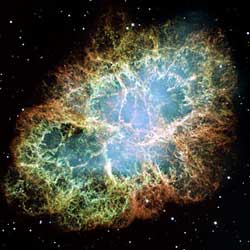Most detailed image of the Crab Nebula

A new Hubble image - among the largest ever produced with the Earth-orbiting observatory - gives the most detailed view so far of the entire Crab Nebula. The Crab is arguably the single most interesting object, as well as one of the most studied, in all of astronomy. The image is the largest ever taken with Hubble’s WFPC2 workhorse camera.
A new Hubble image – among the largest ever produced with the Earth-orbiting observatory – gives the most detailed view so far of the entire Crab Nebula. The Crab is arguably the single most interesting object, as well as one of the most studied, in all of astronomy. The image is the largest ever taken with Hubble’s WFPC2 workhorse camera.
The Crab Nebula is one of the most intricately structured and dynamic objects ever observed. The new Hubble image of the Crab was assembled from 24 individual exposures taken with the NASA/ESA Hubble Space Telescope’s Wide Field and Planetary Camera 2 (WPFC2) and is the highest resolution image of the entire Crab Nebula ever made.
The Crab Nebula is a six-light-year-wide expanding remnant of a star’s supernova explosion. Japanese and Chinese astronomers witnessed this violent event nearly 1,000 years ago in 1054.
The filaments are the tattered remains of the star and consist mostly of hydrogen. The rapidly spinning neutron star embedded in the centre of the nebula, only barely visible in this Hubble image, is the dynamo powering the nebula’s eerie interior bluish glow. The blue light comes from electrons whirling at nearly the speed of light around magnetic field lines from the neutron star. The neutron star, like a lighthouse, ejects twin beams of radiation that appear to pulse 30 times a second due to the neutron star’s rotation. A neutron star is the crushed ultra-dense core of the exploded star.
The Crab Nebula derived its name from its appearance in a drawing made by British astronomer Lord Rosse in 1844, using a 36-inch telescope. When viewed by Hubble, as well as large ground-based telescopes such as ESO’s Very Large Telescope, the Crab Nebula takes on a more detailed appearance that yields clues into the spectacular demise of a star, 6,500 light-years away.
The newly composed image was assembled from individual Wide Field and Planetary Camera 2 exposures taken in October 1999, January 2000, and December 2000. The colours in the image indicate the different elements that were expelled during the explosion. Blue indicates neutral oxygen, green singly ionised sulphur and red doubly-ionised oxygen. The Hubble data have been superimposed onto images taken with the European Southern Observatory’s Very Large Telescope at Paranal Observatory, Chile.
Media Contact
All latest news from the category: Physics and Astronomy
This area deals with the fundamental laws and building blocks of nature and how they interact, the properties and the behavior of matter, and research into space and time and their structures.
innovations-report provides in-depth reports and articles on subjects such as astrophysics, laser technologies, nuclear, quantum, particle and solid-state physics, nanotechnologies, planetary research and findings (Mars, Venus) and developments related to the Hubble Telescope.
Newest articles

Silicon Carbide Innovation Alliance to drive industrial-scale semiconductor work
Known for its ability to withstand extreme environments and high voltages, silicon carbide (SiC) is a semiconducting material made up of silicon and carbon atoms arranged into crystals that is…

New SPECT/CT technique shows impressive biomarker identification
…offers increased access for prostate cancer patients. A novel SPECT/CT acquisition method can accurately detect radiopharmaceutical biodistribution in a convenient manner for prostate cancer patients, opening the door for more…

How 3D printers can give robots a soft touch
Soft skin coverings and touch sensors have emerged as a promising feature for robots that are both safer and more intuitive for human interaction, but they are expensive and difficult…





















